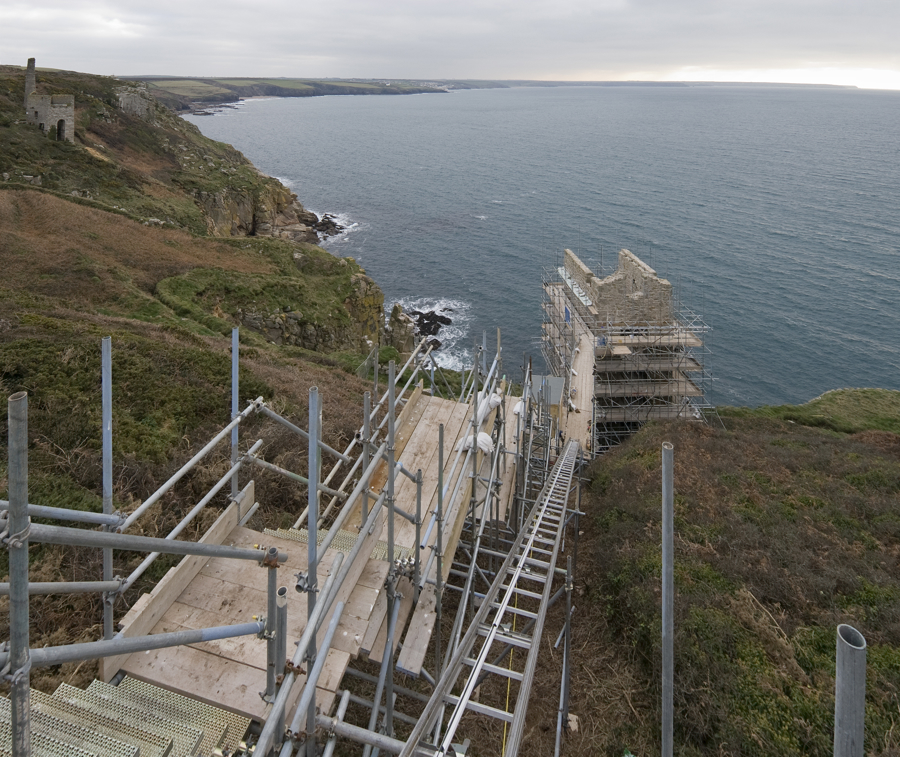(2009) Conservation at Wheal Trewavas
The dramatically located cliff-top engine houses at Wheal Trewavas, near Helston, have recently undergone a major programme of conservation works by The National Trust. Wheal Trewavas is part of just over thirty acres of visually stunning coastline which was acquired by the Trust in February 2008. The funds for the purchase and practical works were raised by the Trust’s Neptune Coastline Campaign, established in 1965 to protect Britain’s coastline, alongside important financial support from generous bequests and legacies. Starting last autumn, the project work to conserve the structures has in total cost £550,000, again with funds generated from the Neptune Coastline Campaign.
Prior to the start of works both engine houses were in a dangerously unstable condition with significant damage having been inflicted by the weather to both the masonry and timber lintels. Following the acquisition of the site detailed archaeological and ecological studies were commissioned by the Trust to inform an appropriate project design, which would respect both the historic value of the mine and the flora and fauna present. Adam Sharpe, a Senior Archaeologist within Cornwall Council’s Historic Environment department undertook the archaeological survey, with additional technical input to the project kindly provided by members of the Trevithick and Carn Brea Mining societies. The works overall were managed by Mike Hardy, Project Manager for The National Trust.
The eventual conservation work was to be sensitively undertaken using only traditional methods and materials, including lime mortar, but the task was made even more difficult due to the exposed and relatively inaccessible location. A spectacular web of scaffolding was erected to facilitate the work, with that enclosing the engine house at Old Shaft, being particularly impressive. This included a tiered stairway with materials conveyor to access the house which is located on a shelf of rock some 15 metres below the cliff top. In total South Shore Scaffolding Ltd. of St Just erected an estimated 39 tonnes of scaffolding and 256 aluminium beams, with a further 400 metres of steel tethering cable being used to secure the structures. The work itself required an additional 40 tonnes of sand and 8 tonnes of building lime in order that the masonry could be completely repointed. The ensuing work was to be carried out to an exemplary standard by former miner Roger MacLean and his team, and they are to be commended for their skill and dedication in so successfully undertaking this challenging project. In addition to conserving the structures, works were also undertaken to improve public access to the site and help develop the area’s potential for nature conservation.
Mike Hardy of the National Trust commented that “The work here to protect these wonderful mine buildings for everyone to enjoy shows just how valuable and relevant the work of the Neptune Campaign is today. We are very grateful to everyone who has been involved in and so supportive of the work at Trewavas in helping achieve such a positive result.”
Deborah Boden, World Heritage Site Co-ordinator, added that “The engine houses at Trewavas offer a glimpse of how precarious mining could be. Whilst visually striking, the delicate condition of these important elements of the World Heritage Site was a cause for concern, and stabilisation of the site is a great achievement. The National Trust is to be congratulated for the enthusiasm and commitment they have shown both to this site and the other internationally important industrial heritage assets throughout the World Heritage Site in their care.”
Wheal Trewavas is part of the A3 Area of the Cornish Mining World Heritage Site (i.e. the Tregonning and Gwinear Mining District with Trewavas); it is a Scheduled Monument, with the engine houses also Listed Buildings (Grade II). The spectacular landscape and coastline from Marazion to Falmouth, within which the mine sits, is also part of the Cornwall Area of Outstanding Natural Beauty (AONB).
Works were finally to be concluded in May this year, with the completion of this outstanding project being officially celebrated with an invited audience in July.
Ainsley Cocks, 2009
